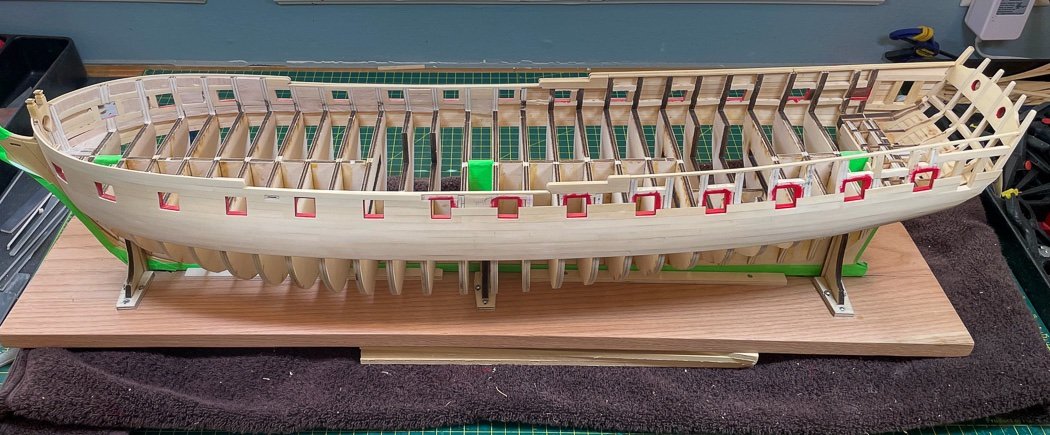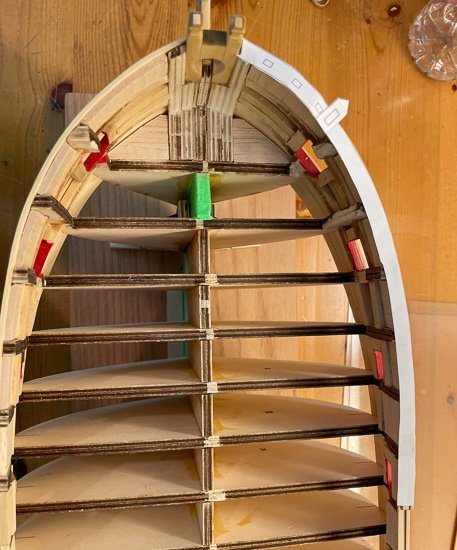-
Posts
4,126 -
Joined
-
Last visited
Content Type
Profiles
Forums
Gallery
Events
Everything posted by glbarlow
-
For Flirt I did it like BE described, with the plans, a pin vise, and eyeballing the angle. For Cheerful I was a bit more exacting by inserting a fake mast with lines tied on, I ran those lines to match the plans then pre-drilled the holes based on those lines and finally glued the chain plates on with the standard little nails. It’s shown in my build log (post #496), if that helps.
- 505 replies
-
- vanguard models
- Sphinx
-
(and 1 more)
Tagged with:
-
Which is the correct carriage size for the 1 9/16 barrels? I probably missed it, is the binnacle a mini-kit, I don’t see one on SSMS?
- 1,784 replies
-
- winchelsea
- Syren Ship Model Company
-
(and 1 more)
Tagged with:
-
A fun little project, it looks great.
- 642 replies
-
- winchelsea
- Syren Ship Model Company
-
(and 1 more)
Tagged with:
-
😊Not what I was referencing, I’m glad it helps you. Btw, it’s a poor substitute for lining the hull to really get it right but it works.
- 362 replies
-
- Amati
- Lady Nelson
-
(and 2 more)
Tagged with:
-
I’ll skip providing any further comments, enjoy your build.
- 362 replies
-
- Amati
- Lady Nelson
-
(and 2 more)
Tagged with:
-
Common problem from not overlapping the next plank to the one above it and starting the taper where they naturally cross. You’ve started all the tapers for the bow too far back. Another reason for the importance of lining the hull. It gets better with practice.
- 362 replies
-
- Amati
- Lady Nelson
-
(and 2 more)
Tagged with:
-
Thanks Bob, it’s definitely nice to have those templates now.
- 840 replies
-
- winchelsea
- Syren Ship Model Company
-
(and 1 more)
Tagged with:
-
It’s a process. Still working on cutting out ports to complete planking above the wales. I finished the port side bow and needed a change of pace after fitting 20 ports (8 more to go) so I decided to do some preliminary fairing on the starboard interior. I’ve added 1/8 balsa between the frames to act as spacer, that plus the planking gets me close to the 3/16 required. I’m not done still more to do, but its close. It’s a little heart stopping to grind this out with a very light touch of the Dremel. It is made a little easier, still requiring deep slow breaths, by my new addition of a Proxxon pen sander for a lighter touch, then by hand and with chisels to clean up when I get close. I have it close enough now to go back later and polish up what I’ve done and complete the starboard interior. Really I just wanted to establish a little confidence I could pull it off and not have a port sill fly off the ship. Cheerful now seems like a piece of cake comparatively. Good news, with both sides of the bow now planked above the wales I’ve confirmed via the Chapter 9 template they meet the required shape for when, in the far distant future, I get to Chapter 9. Back to the port side planking now.
- 840 replies
-
- winchelsea
- Syren Ship Model Company
-
(and 1 more)
Tagged with:
-
Don't have to hope for the best. Leave the aft edge on those forward of the waist and fore edge on those aft of the waist (so as not to overdue it and lose the shape and to keep both sides even) while taking the edges off the couple of center bulkheads so its smooth all the way. The batten needs to contact at least 90% of the bulkhead but if done well it will contact 100% of every bulkhead front to back. The stern takes a little more attention to follow the flow to the counter, it isn't especially hard on Flirt as my log will show. Slide the very thin batten up and down covering at least 4-5 bulkheads at a time, up and down back and forth - it will be right. Then it's just tapering and edge bending the first planking and you're home.
-

Red Ochre Paint
glbarlow replied to starlight's topic in Painting, finishing and weathering products and techniques
Admiralty Paints Red Ochre is the best there is. Get it from Cornwall boats, excellent service whatever country your in. -
I don’t know, that shocking orange color of the Sphinx could be the way to go 🤣😂
- 857 replies
-
- Sphinx
- Vanguard Models
-
(and 1 more)
Tagged with:
-
It really looks great, so meticulous.
- 607 replies
-
- winchelsea
- Syren Ship Model Company
-
(and 1 more)
Tagged with:
-
You are certainly doing a lot of nice custom work on this model, all exacting and well done!
- 419 replies
-
- Victory Models
- Pegasus
-
(and 2 more)
Tagged with:
-
You should fare the bulkheads so there is a smooth run of a test plank fore to stern before adding the gunport strips, the probably would fit better. You definitely need to fare them before starting planking. The deck needs to be pushed / weighed down and glued to the bottom of the bulkheads side to side forming a slightly bowed deck before the gunport parts are added. Hang in there, solving problems is have to fun, for me creating often seems to be the other half.
- 65 replies
-
- Ballahoo
- Caldercraft
-
(and 1 more)
Tagged with:
-
I think what we did with part 21 is perfectly logical 😊 As you probably discovered the bulkheads have a little notch at their base. The way to get the deck to fit is to get one side to fit under the notches then work it down the other side to fit into those notches. It is not a simple task for sure and I don’t recall if the notches are mentioned in the instructions. The notches are a great idea for holding the deck, not fun to get it there. The stern frames are indeed fragile little things. Solving problems and fixing mistakes is all part of the fun, you did it and you’re moving forward, congratulations!
About us
Modelshipworld - Advancing Ship Modeling through Research
SSL Secured
Your security is important for us so this Website is SSL-Secured
NRG Mailing Address
Nautical Research Guild
237 South Lincoln Street
Westmont IL, 60559-1917
Model Ship World ® and the MSW logo are Registered Trademarks, and belong to the Nautical Research Guild (United States Patent and Trademark Office: No. 6,929,264 & No. 6,929,274, registered Dec. 20, 2022)
Helpful Links
About the NRG
If you enjoy building ship models that are historically accurate as well as beautiful, then The Nautical Research Guild (NRG) is just right for you.
The Guild is a non-profit educational organization whose mission is to “Advance Ship Modeling Through Research”. We provide support to our members in their efforts to raise the quality of their model ships.
The Nautical Research Guild has published our world-renowned quarterly magazine, The Nautical Research Journal, since 1955. The pages of the Journal are full of articles by accomplished ship modelers who show you how they create those exquisite details on their models, and by maritime historians who show you the correct details to build. The Journal is available in both print and digital editions. Go to the NRG web site (www.thenrg.org) to download a complimentary digital copy of the Journal. The NRG also publishes plan sets, books and compilations of back issues of the Journal and the former Ships in Scale and Model Ship Builder magazines.







